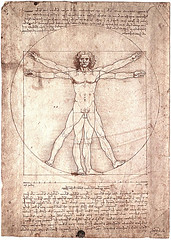Tuesday, April 08, 2008
Vitruvian Man or the Canon of Man, Leonardo da Vinci, about 1500
Leonardo da Vinci's Vitruvian Man (1492). Pen and ink with wash over metalpoint on paper, 344 × 245 mm, acc to wikipedia.
The Vitruvian Man is a world-renowned drawing with accompanying notes created by Leonardo da Vinci around the year 1492 as recorded in one of his journals. It depicts a nude male figure in two superimposed positions with his arms and legs apart and simultaneously inscribed in a circle and square. The drawing and text are sometimes called the Canon of Proportions or, less often, Proportions of Man. It is stored in the Gallerie dell'Accademia in Venice, Italy, but is only displayed on special occasions.[1][2]
This image exemplifies the blend of art and science during the Renaissance and provides the perfect example of Leonardo's keen interest in proportion. In addition, this picture represents a cornerstone of Leonardo's attempts to relate man to nature.
Subscribe to:
Post Comments (Atom)


No comments:
Post a Comment